After 30 years, Buddhist-inspired message of ‘Groundhog Day’ still holds spiritual power
Part Hollywood love story and part secular spiritual parable, the 1993 film shows life can be better if we pay attention.
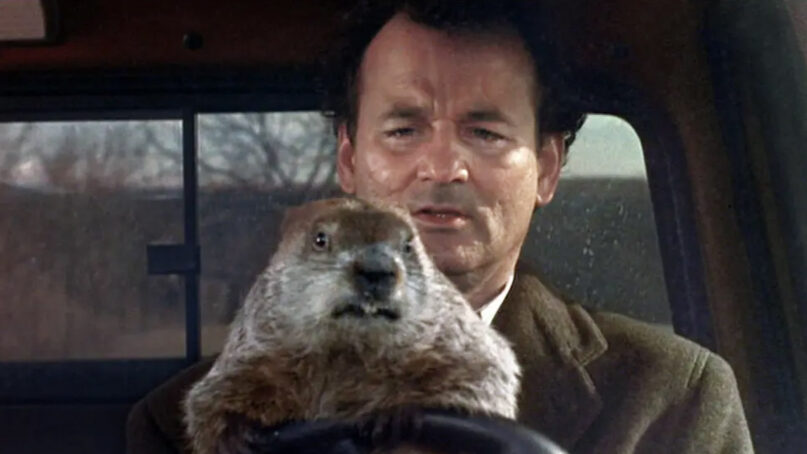
WOODSTOCK, Ill. (RNS) — Woodstock Willie, perhaps the second most famous groundhog in the country, saw his shadow Thursday (Feb. 2), predicting another six weeks of winter.
The early morning prediction, viewed by a crowd who braved below-freezing temperatures, was part of a five-day celebration of the release of “Groundhog Day,” a now classic film starring Bill Murray released in 1993 and filmed in this small town about an hour northwest of Chicago.
Despite almost no mention of God or religion, the filmmakers made one of the more spiritual films of the era.
“You can argue about whether it is a Buddhist, Christian or Jewish movie — but it is deeply religious,” said author and Boston University religion professor Stephen Prothero, who has shown the film in his classes.
“Groundhog Day” tells the story of Phil Connors, a self-centered TV weatherman sent to Punxsutawney, Pennsylvania, to cover the annual Groundhog Day festival at Gobbler’s Knob, where it’s been celebrated since 1887. (The movie’s creators chose to film it in Woodstock because the city’s historic square and downtown shops meant most of the film could be shot nearby.)
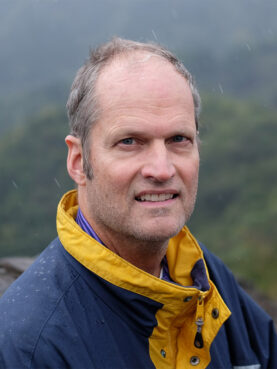
Stephen Prothero. Photo by Meera Subramanian
A blizzard blocks the departure of Connors and his colleagues, forcing them to stay overnight. But when he awakes a second morning to the same song on the radio — Sonny and Cher’s 1965 hit “I Got You Babe” — Connors discovers he’s stuck reliving the same day, over and over again.
No matter what he does, Connors wakes up every morning to the same song, in the same room at a Woodstock bed-and-breakfast. Not even death gives him release.
It turns out that immortality and reincarnation, at least for Connors, is not such a good thing.
When Americans think of reincarnation, they think it means an opportunity for a new life. But the Buddhist idea of reincarnation is actually a curse, said Prothero, because it often means reliving the same life over and over.
Brook Ziporyn, a professor of Chinese religion, philosophy and comparative thought at the University of Chicago, said Connors appears to be stuck in what Buddhists call “samsara” — a cycle of death and rebirth that’s marked by suffering. The fact that Connors is stuck in a place he despises reinforces that idea.
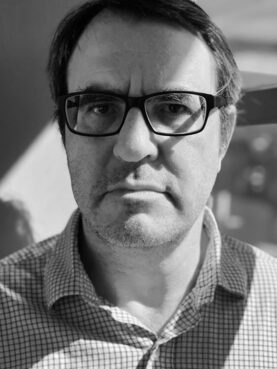
Brook Ziporyn. Photo by Howard Wallach
“It has to be in a place that he hates,” said Ziporyn, who has taught about the Buddhist themes in “Groundhog Day” and other films, including “What About Bob?”, which also starred Bill Murray. During the movie, Connors discovers his eternal life is without consequences. At first, he uses that as a license to do whatever he wants by indulging in all seven deadly sins. He robs an armored car, steals the groundhog, seduces women in town by lying to them and gorges himself at the local diner, for starters.
All of that proves meaningless.
He finally has a moment of clarity when he is rejected by his colleague Rita, played in the film by Andie MacDowell. Despite his best efforts, and repeated failure, he can’t win her heart because she sees through him.
“I could never love someone like you. You only love yourself,” she tells him.
“That’s not true,” Connors replies. “I don’t even like myself.”
Connors begins to change at that moment, not because God or a spiritual figure tells him to, but because in the end, being a jerk makes him unhappy. He devotes his time to improving himself — learning to play the piano, for example — and to doing good deeds. He eventually practices most of the so-called seven heavenly virtues — things like patience, diligence, kindness and humility.
By giving up his own ambitions, he eventually wins Rita’s heart.
“It is not that he has a revelation of God’s law,” said Ziporyn. “He just realizes that the only thing he can do that makes himself meaningful is to start engaging others.”
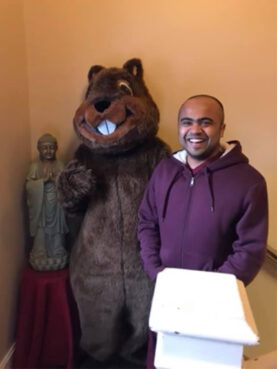
Bhante Amitha with a groundhog mascot in Woodstock, Illinois. Courtesy photo
Bhante Amitha, the deputy abbot of the Blue Lotus Temple, a Buddhist center located about a block from where “Groundhog Day” was filmed, said he’d only seen the trailer for the movie, so he could not comment on the specific religious themes in it.
A Theravada monk originally from Sri Lanka, Bhante Amitha said meditation and good works can help people find relief from the stresses and worries of life. About 60 people, most of whom were brought up in Christian or Jewish traditions, take part in the regular Saturday meditation classes at the temple, according to the abbot.
He said that striving and attachment and anger can be like poisons — and that relief can be found in meditation and good deeds. Those deeds and compassion can help people escape the cycle of samsara.
“Our main goal is to practice meditation and generosity and having a virtuous life,” he said.
Tessa Fisher, the office manager for the temple and an adherent, said she’d seen “Groundhog Day” a few times but had never really thought about the parallels between Buddhist teaching and the film. But she said people who come to the temple, housed in what was built as a Congregationalist church, are often struggling.
“They are on a spiritual journey,” she said. “They are seeking something. And by practicing or reading they have this kind of awakening in themselves. They realize they need to give love and kindness to themselves so that they can do good to others.”
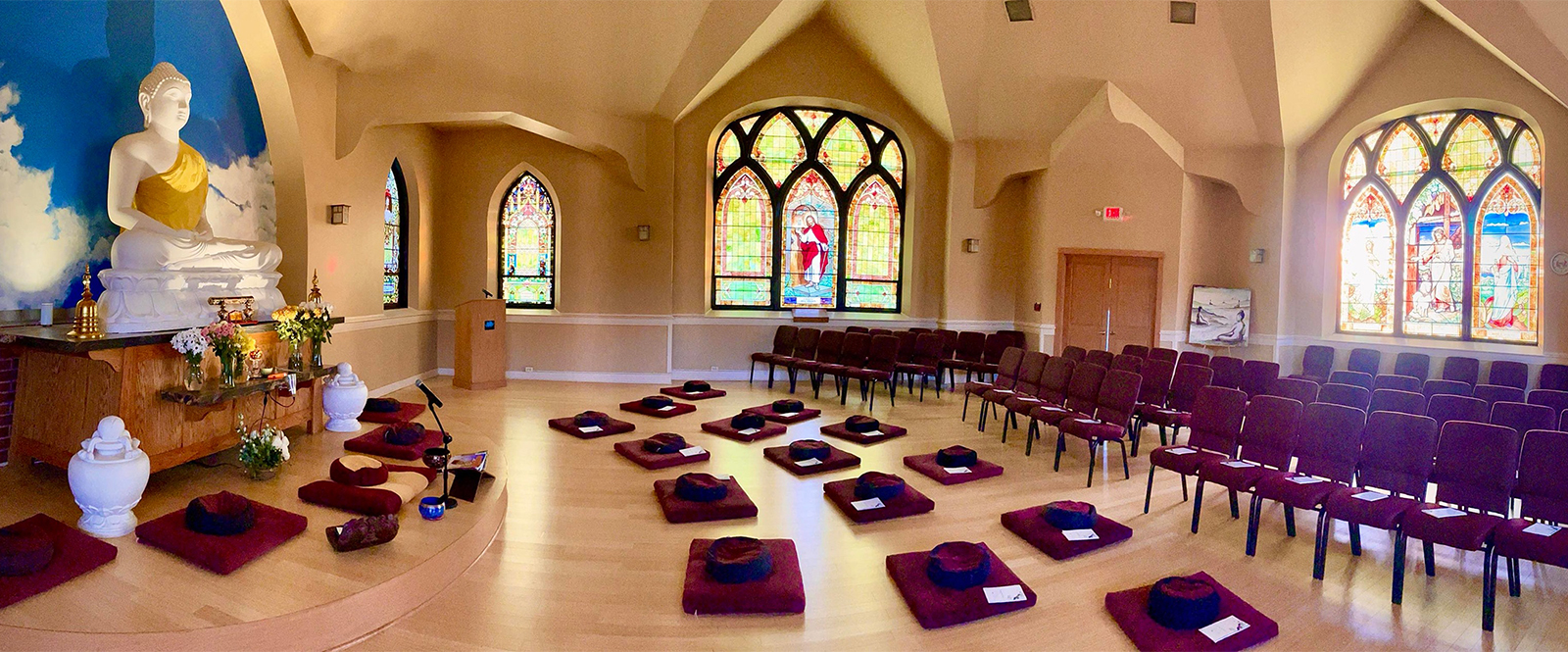
Dhamma hall in the Blue Lotus Temple in Woodstock, Illinois. Courtesy photo
In that way, she said, they are like the main character of “Groundhog Day.”
“They take that step and say I want to break out of my struggles.”
Part of the genius of “Groundhog Day” is that it is open to interpretation. The film’s screenwriter, Danny Rubin, has said he’s heard from preachers and rabbis and Buddhist practitioners and grief counselors, all of whom say the movie reflects their teaching.
The first draft of the screenplay for the movie, published in Rubin’s 2012 book “How to Write Groundhog Day,” included scenes with a Catholic priest and a street preacher.
“Forswear your ways, your greed, your selfishness,” the street preacher says in that first draft. “Realize your true destiny, for only then you will live in the world.”
Those scenes were removed as Rubin and director Harold Ramis revised the screenplay. In his book, Rubin included a series of lessons he learned from the process of writing and rewriting the movie.
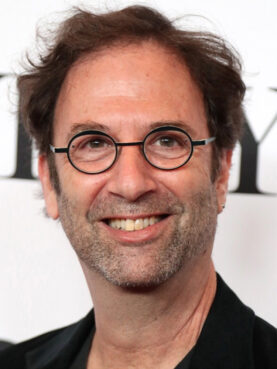
Danny Rubin. Courtesy photo
Those lessons included the importance of perspective: In the movie, Connors experiences both the worst day of his life and the best day. Things change for him, Rubin wrote, as he changes the way he looks at things. Rubin wrote that he also learned the importance of paying attention — that Connors learns to see the people he encounters every day and to hear their stories, rather than just focusing on himself.
Rubin also learned that even a single day in a small town can be filled with possibilities.
“Every day held an infinite number of stories,” he wrote.
Ramis, who died in 2014, said in a short documentary about the making of “Groundhog Day” that the film reflected his philosophy of life.
What Danny and I both wanted to say with the movie is, you can live better,” he said. “You can have a better life. People can change. And when you do change you get those rewards you think you want from life.”
Author and Hamilton College religion professor Brent Rodriguez-Plate, who has often taught “Groundhog Day” in classes about religion and film, said removing explicitly religious elements from the script helps give the film its power.
People are free to interpret the film however they want, he said.
“The fun thing about it is that it is so completely secular,” said Rodriguez-Plate. “It’s the Hollywood myth that trumps all the other religious myths — annoying man finally gets his stuff together and figures out how to be worthy of the beautiful woman. That’s why we keep coming back to it.”
Groundhog Day: Fred is dead in Quebec, Willie and Sam at odds over spring's arrival
Thu, February 2, 2023
The death of a prognosticating rodent in Quebec cast a shadow over Groundhog Day festivities on Thursday, while the notable furry forecasters who made their predictions were split over spring’s arrival.
Fred la Marmotte is dead, organizers in Val D’Espoir, Que., told the crowd that had gathered in anticipation of the rodent's annual prediction.
The announcement came after most of the event, including a dance break with a large Fred mascot, had taken place without indication of the animal's death.
"In life, the only thing that is certain is that nothing is certain,” Roberto Blondin, an organizer, eventually told the crowd.
Blondin explained that Fred did not have vital signs when efforts were made to wake the animal from a winter slumber. He said the nine-year-old groundhog likely passed away in the late fall or early December.
In Fred's place, organizers pulled a stuffed toy groundhog from Fred's miniature wooded cabin, handed it to a young boy and then lifted the child in the air. The boy later convened with other kids on a stage before calling for six more weeks of winter.
According to folklore, if a groundhog sees its shadow on Groundhog Day, winter will drag on. However, if it doesn't spot its shadow, spring-like weather will soon arrive.
Among the famous Canadian groundhogs who made it to sunrise, predictions were divided.
Ontario's Wiarton Willie called for an early spring while Shubenacadie Sam, Nova Scotia's most famous groundhog, apparently saw her shadow Thursday morning as she emerged from a snow-covered enclosure at a wildlife park north of Halifax.
The turn of events in Quebec recalls Groundhog Days gone by.
On Groundhog Day 1999, children burst into tears when Wiarton Willie's handlers announced the groundhog had died two days before. In his place, a white groundhog they claimed to be Willie was brought out in a tiny pine coffin, holding a carrot.
The scene made international headlines but the mayor of the Town of South Bruce Peninsula had to later admit the stuffed groundhog in the casket was not, in fact, Willie, but a stand-in.
On Groundhog Day 2021, there was more Willie controversy.
The groundhog was nowhere to be seen for the virtual festivities on the decisive morning – the town released a video that showed the mayor tossing a fur hat and making the annual prediction. There was no in-person event due to the pandemic.
It took nine months before the town acknowledged the white-furred albino rodent had died.
Willie's handlers in South Bruce Peninsula brought in an understudy last year, but that animal was the usual brown colour — a break from a decades-old tradition.
This year's replacement — another white groundhog — was recruited last summer from Cleveland, Ohio, said town spokesperson Danielle Edwards.
That Willie was brought out on stage in a Plexiglas box on Thursday and South Bruce Peninsula Mayor Garry Michi put an ear to the box and declared the rodent had heralded spring's arrival. Local legend has it the mayor is the only person who can speak "Groundhogese".
Just after 8 a.m. local time in Shubenacadie, N.S., the door to Sam's pint-sized barn was opened, and she slowly backed out into the cold, and then scurried over the snow towards a fence.
The annual tradition at the Shubenacadie Wildlife Park, broadcast live on Facebook, has been closed to visitors for the past two years because of COVID-19 gathering restrictions – and the in-person festivities were cancelled in 2020 because of a storm.
But a small crowd, including a group of children, braved the -20 C weather Thursday.
As expected, Sam was the first groundhog in North America to make a prediction — thanks to the Atlantic time zone.
Meanwhile, in the United States, Punxsutawney Phil agreed with Sam, predicting six more weeks of winter. Phil's prediction came during a week when ice, sleet and snow has lingered across much of the southern U.S.
Folklorists say the Groundhog Day ritual may have something to do with Feb. 2 landing midway between winter solstice and spring equinox, but no one knows for sure. In medieval Europe, farmers believed that if hedgehogs emerged from their burrows to catch insects, that was a sure sign of an early spring.
However, when Europeans settled in eastern North America, the groundhog was substituted for the hedgehog.
In a playful, peer-reviewed study published by the American Meteorological Society, researchers at Lakehead University in Thunder Bay, Ont., concluded that groundhogs are "beyond a shadow of a doubt" no better at predicting spring's arrival than flipping a coin.
- with files from Sidhartha Banerjee in Montreal and Michael MacDonald in Halifax.
This report by The Canadian Press was first published Feb. 2, 2023.
Jordan Omstead, The Canadian Press
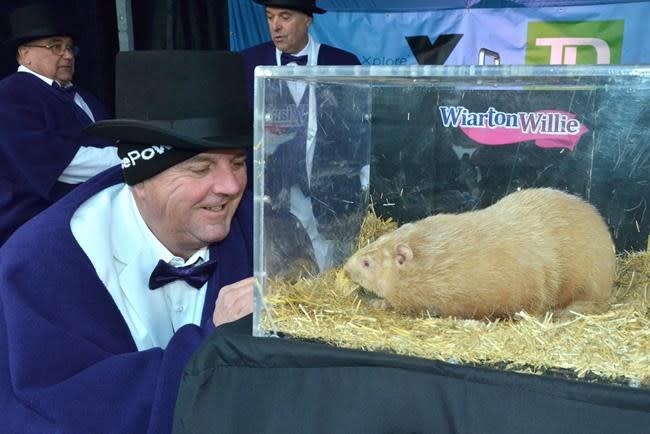
No comments:
Post a Comment